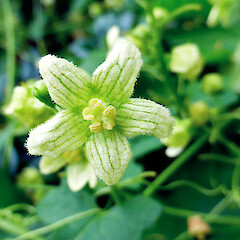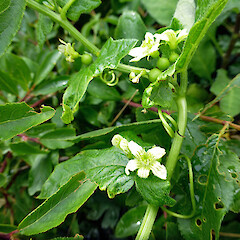Bryonia cretica subsp. dioica
Common name
white bryony
Family
Cucurbitaceae
Flora category
Vascular – Exotic
Structural class
Lianes & Related Trailing Plants - Dicotyledons
Conservation status
Not applicable
Habitat
Terrestrial. Disturbed and open forest and shrubland, stream edges
Detailed description
Soft, summer-green, cucumber-like vine to 6 m tall, dying back in autumn to perennial tuber. Tubers brittle, branching, huge; branches 45-160 x 100- 800 cm, oriented vertical to horizontal. Stems arise from end of tuber, soft; with slender, coiling tendrils. Leaves to 15 x 15 cm, thin, 5-lobed, middle lobe longest. Flowers tubular, to 2 cm long, whitish with green stripes. Fruit round, 4-8 mm diam, smooth skinned, succulent, yellow turning red, many-seeded, 5-8 clustered.
Similar taxa
Sicyos australis (mawhai) (indigenous) has prickly 1-seeded fruits. Tamus communis (black Bryony) is also similar.
Flowering
December, January, February
Flower colours
Green, White
Fruiting
Jan-march
Life cycle
Perennial. Spreads by seeds and vegetatively by tuber fragments. Many seeds contained within each fruit. Tuber fragments can spread via water, soil disturbance, garden refuse. Seed dispersed by birds.
Year naturalised
1991
Origin
Eurasia/Mediterranean
Reason for introduction
Ornamental
Tolerances
Tolerates wet to seasonal drought, warm to cool, variety of soils, semi shade. Poisonous so not browsed.
Etymology
dioica: Two plants
National Pest Plant Accord species
This plant is listed in the 2020 National Pest Plant Accord. The National Pest Plant Accord (NPPA) is an agreement to prevent the sale and/or distribution of specified pest plants where either formal or casual horticultural trade is the most significant way of spreading the plant in New Zealand. For up to date information and an electronic copy of the 2020 Pest Plant Accord manual (including plant information and images) visit the MPI website.






